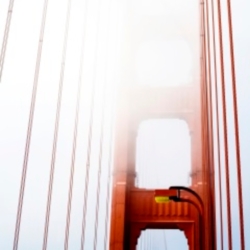 San Franciso’s Golden Gate Bridge is not only known as the most photographed structure in the USA but also for it’s more intriguing title as the most popular site for suicide jumps in the world. Over 1,200 people have travelled to this location to take their own lives since the bridge opened in 1937. In fact, the rate of suicide is rising and, as Denise Oliveri reports, officials are struggling to stop the frenzy.
San Franciso’s Golden Gate Bridge is not only known as the most photographed structure in the USA but also for it’s more intriguing title as the most popular site for suicide jumps in the world. Over 1,200 people have travelled to this location to take their own lives since the bridge opened in 1937. In fact, the rate of suicide is rising and, as Denise Oliveri reports, officials are struggling to stop the frenzy.
The drop from the Golden Gate Bridge is approximately 260 feet. It takes a quick four seconds to drop from the deck of the bridge to the waters below, and at a speed of 75 mph it is almost always an instant death. With such a fast impact many jumpers are convinced they won’t feel a thing, making the idea of suicide more tolerable at this location.
The Golden Gate Bridge has been a popular jump site for people wanting to commit suicide since the bridge opened in 1937. As of October 2003, there have been approximately 1,200 successful suicide attempts made here1, a figure that has captured the attention of people worldwide. The latest statistics show there is one new successful suicide attempt made at the Golden Gate Bridge every two weeks.
Marin County Coroner, Ken Holmes, reports that 206 people committed suicide by jumping off the bridge from 1997 to 2007. Fifty-nine of these incidents were by San Francisco residents, and made up a third of the total, but others travelled great distances just to plunge to their death at this location.
The fall is brutal and violent. For most, death is immediate, but for a few they will land in the water in such a way they do not instantly die but with injuries they are plummeted below the frigid water to a slow and agonizing death.
Reducing Suicide Attempts
One proposal to reduce the number of suicide jumpers at the Golden Gate is to increase the height of the bridge railings, making it more difficult for jumpers to perform the plunge into the waters below. The problem with making higher rails is that they may not be able to withstand the 100 mph winds sometimes seen at this height. Different designs for barriers have been discussed by officials for years, but have met with much opposition from residents who don’t want the barriers in place.
Cost has been a major issue for building the barriers, which could cost approximately $20,000,0003. Experts point out that barriers have improved suicide rates at places like the Eifel Tower in Paris and the Empire State Building in New York, but officials worry that these new barriers could cause safety issues for the bridge, especially in the case of high winds.
The bridge has suicide hotline phones installed along the path in the hope that those in desperation will make a call in lieu of jumping. Other precautions undertaken are that the bridge is closed to pedestrians at nightfall (with the exception of cyclists who are allowed access by staff through security gates) and beefed up security has been placed along the bridge where staff will patrol and look for any potential jumpers4.
Survivors of the Jump
As of 2006, only 26 people are known to have survived the jump and most have died later from internal injuries2. These “survivors” usually land feet first in the water and sustain multiple fractures and damage to internal organs such as ruptured spleens.
For most their first attempt will be their last but in a suprising case a young woman who jumped once and survived in 1988, took the plunge again later that same year and died. For her the attraction of the now infamous ‘Bridge of Death’ was just too much.
For more information on the suicide prevention efforts visit the Golden Gate Suicide Barrier Coalition at http://www.goldengatecitizens.com/suicide/info_where.htm.
References
1,2. Jumpers: The fatal grandeur of the Golden Gate Bridge. The New Yorker, 2003.
3. “Deadly Beauty.” The Economist, 2006)
4. “Golden Gate Bridge: Bikes and Pedestrians.” Golden Gate Bridge, Highway and Transportation District, 2006



